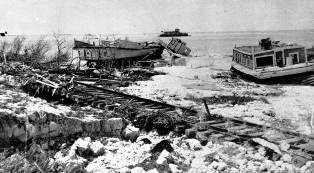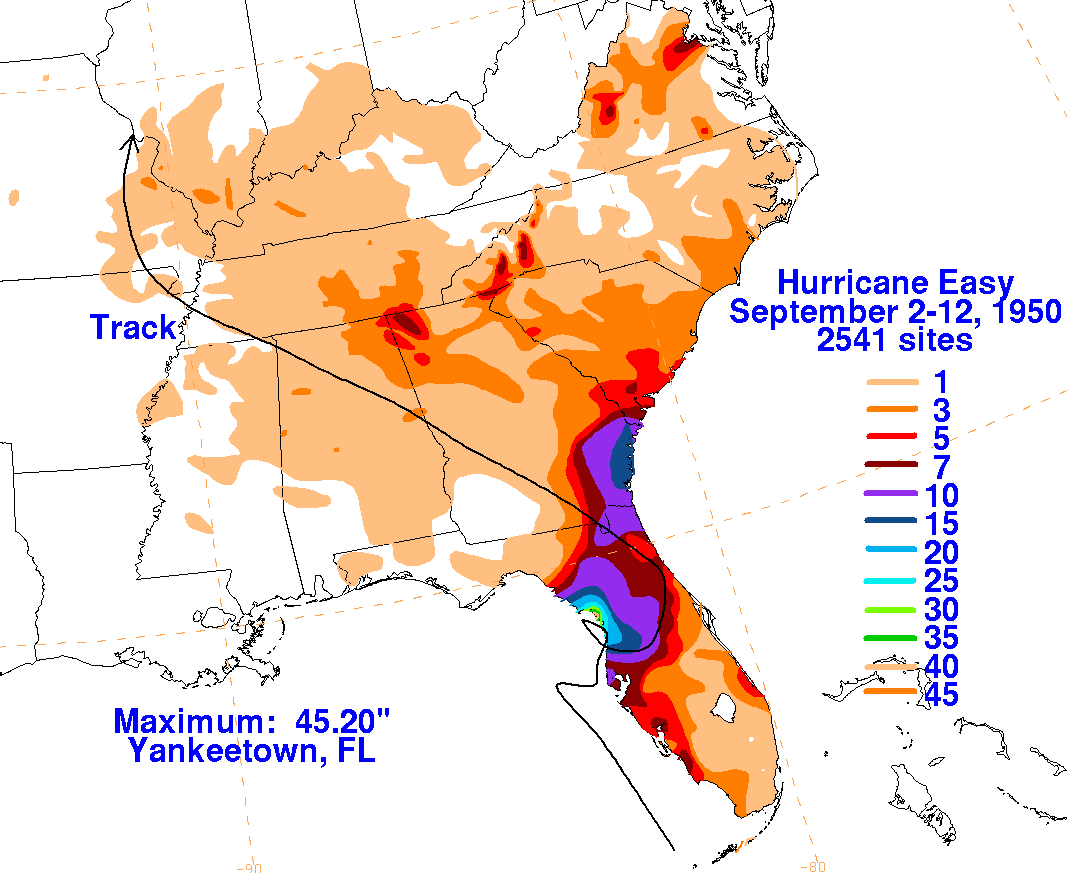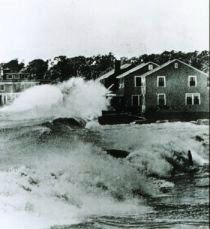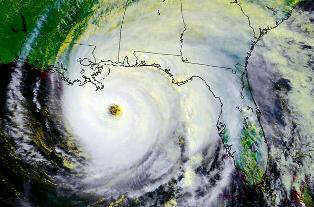The list of Florida hurricanes encompasses approximately 486 tropical or
subtropical cyclones that affected the state of Florida. More storms hit
Florida than any other U.S. state, and since 1851 only eighteen
hurricane seasons passed without a known storm impacting the state.
Of the 34 major hurricanes in Florida’s recorded history of storms to
make landfall or produce Category 3 winds in Florida, 18, have occurred
in the month of September. I thought it would be fitting to reflect on some of Florida's best known September hurricanes.

The Labor Day Hurricane of 1935 was the
first ever Category Five Hurricane on record to hit the United States.
The compact and intense hurricane caused extreme damage in the upper
Florida Keys, as a storm surge of approximately 18 to 20 feet affected
the region. The hurricane's strong winds destroyed most of the buildings
in the Islamorada area, and many World War I veteran workers were killed
by the storm surge. Portions of the Key West Extension of the Florida
East Coast Railroad were severely damaged or destroyed. The evacuation
train, which left Homestead was filled with veterans and 100s of other
locals from the keys came to a sudden halt. When it reached the
Islamorada water tank the 10 cars were tossed off the track and over on
their sides by powerful waves that were now surging over the islands.
The engine alone remained on its wheels, but it ceased to move because
the fire in the box was out. The hurricane also caused additional damage
in northwest Florida, Georgia, and the Carolinas. In total, more than
400 people were killed.

Hurricane Easy Easy hit Florida in September of 1950 and
produced the scariest weather for a 24-hour period in this section of
the Gulf Coast. Easy hit
Cedar Key
on Sept. 5 as Category 3 storm and looped back
out to sea before hitting Cedar Key again, which caused the town to face
the same side of the storm twice and experience the eye for 2 1/2
hours. Following the loop, Easy headed back out to the Gulf briefly in a
southeasterly direction before hitting land again at Hernando Beach and
heading northeast across the state toward Jacksonville.The hurricane
produced 100 mph winds in Cedar Key for 9 1/2 hour! Because of its
unusual trek and low barometric pressure (28.30
inches), Easy caused some unusual occurrences. Cedar Key experienced
24.5 inches of rain in a three-day period, while Yankeetown took on 38.7
inches of rain in 24 hours, a record amount for the U.S. at the
time.The low barometric pressure was also blamed for mysterious blisters
forming on cars following the storm. Apparently the low pressure caused
air pockets to form under layers of paint.
Cedar Key lost its entire fishing fleet of more than 100 boats.
Ninety percent of its buildings were damaged and 150 homes lost their
roofs. Miraculously, no one in Cedar key was killed by the storm.
In 1960 Hurricane Donna caused big trouble for Florida. After swiping the Florida Keys and striking land
near Fort Myers on Sept. 10, '
Deadly Donna' did not travel along the
usual path that storms of her magnitude usually take. Instead of heading
back to the Atlantic Ocean or the Gulf of Mexico, Donna took on the
unusual distinction of being the only hurricane of record to produce
hurricane-force winds throughout the U.S. East Coast from Florida, the
Mid-Atlantic states and New England. The hurricane's center passed
through 60 miles west of Miami, sparing Broward County.
This time, Broward residents only experienced 80 mile-per-hour winds as
Donna's fringes passed by, causing a few trees and signs to tumble down.
Unfortunately, residents in the Florida Keys fared worse, having to
endure 13-foot storm surges and 150 mile-per-hour winds. Bridges were
washed away and homes resembled splintered matchsticks for miles. The
Fort Lauderdale
News reported that the Tampa Weather Bureau predicted statewide
property damage to reach $2 billion. Hurricane Donna was the
fifth-strongest hurricane of record to hit the U.S., causing 50 deaths,
$387 million in property damage and affected over 50 million people
according to the National Hurricane Center.
Fifty years ago this week, Hurricane Dora hit
St. Augustine. It was the
first
hurricane to strike north of Stuart on the East Coast of Florida
since 1880. While the subsequent 10-foot storm surge and 125 mph winds severely
damaged the St. Augustine area, it was the back end of Dora that caught
the attention of Citrus County residents and emergency personnel on
Sept. 10, 1964. Pushed along by 60 mph winds, a high tide, 6 feet above
normal, rolled in, flooding the Gulf Coast from Citrus County to the
Panhandle.
Category-2
Hurricane Frances came ashore on the
central east coast of Florida on September 5, 2004. Hurricane Frances
was the sixth named storm, the fourth hurricane, and the third major
hurricane of the 2004 Atlantic hurricane season. The system crossing the
open Atlantic during mid to late August, moving to the north of the
Lesser Antilles while strengthening. Frances then passed over the
central sections of the state of Florida in the U.S. only three weeks
after Hurricane Charley, causing significant damage to the state's
citrus crop, and closing schools. The storm then moved briefly offshore
Florida into the northeast Gulf of Mexico and made a second U.S.
landfall at the Florida Panhandle before accelerating northeast through
the eastern United States near the Appalachians into Atlantic Canada
while weakening. A significant tornado outbreak accompanied the storm
across the eastern United States, nearly equaling the outbreak from
Hurricane Beulah. Very heavy rains fell in association with this slow
moving and relatively large hurricane, which led to floods in Florida
and North Carolina. Some areas of Florida received over 13 inches as the
system moved slowly through the state. Heavy rains caused a large
sinkhole to develop on Interstate 95 in Palm Beach County, which closed
the highway to traffic. Frances caused heavy damage to the large Vehicle
Assembly Building at the Kennedy Space Center, ripping off over a
thousand 4-by-10 foot aluminum panels used to clad the building. A total
of 49 lives were lost from the cyclone. Damages totaled $12 billion.

Hurricane Ivan lived up to name of "Ivan the Terrible when it made landfall on September 16, 2004. The hurricane was the strongest
hurricane of the 2004 Atlantic hurricane season and the tenth most intense Atlantic
hurricane ever recorded. The cyclone formed as a Cape Verde-type
hurricane in early September and became the ninth named storm, the sixth
hurricane, and the fourth major hurricane of the year. Ivan reached
Category 5 strength on the Saffir-Simpson Hurricane Scale, the strongest
possible category. At its peak in the Gulf of Mexico, Ivan was the size
of the state of Texas. It also spawned 117 tornadoes across the eastern
United States. After peaking in strength, the hurricane moved
north-northwest across the Gulf of Mexico to strike Gulf Shores, Alabama
as a strong Category 3 storm, causing significant damage. Ivan dropped
heavy rains on the Southeastern United States as it progressed northeast
and east through the eastern United States, becoming an extratropical
cyclone. The remnant low from the storm moved into the western
subtropical Atlantic and regenerated into a tropical cyclone, which then
moved across Florida. Ivan caused an estimated $13 billion in
damages to the United States.








Comments
Post a Comment